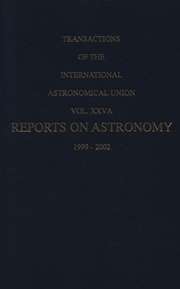No CrossRef data available.
Article contents
20. Commission Pour l’Observation des Positions et le Calcul des Éphémérides des Petites Planètes, des Comètes, et des Satellites
Published online by Cambridge University Press: 25 April 2016
Extract
In accordance with suggestions made by members of the Commission further consideration of the following topics is proposed:
(1) Improvement of the present plan for distribution of observations and computations relating to minor planets and comets, with special reference to those which depart considerably from their ephemerides.
(2) Designation of a central bureau to supervise any accepted plan for coordination of observations and computations. It is suggested that separate bureaus be established for Minor Planets and for Comets.
(3) Systematic investigations of the orbits of the recently discovered objects designated as minor planets: Reinmuth 1932 HA, and Delporte 1932 EA1( and other objects of similar interest.
(4) Financing of proposals (2) and (3).
(5) Standard equinoxes as proposed by Comrie (1950.0) and by Bower (1900.0).
(6) Designation of published residuals as observed residuals rather than referring to the epoch of the comparison star.
(7) Greater adherence to the convention “That the dates used in giving the osculation epochs of elements for comets and minor planets shall be the midnight following an integral Julian date which is exactly divisible by 40, and for ephemerides, divisible by 8 (or 4, etc.),” to facilitate intercomparison of ephemerides and elements.
(8) Inauguration of complete residuals of comets, similar to those of minor planets with provision for their continuation.
(9) Inclusion in astronomical telegrams of some information of a descriptive nature to indicate the accuracy of the measured position, in confirmation of previous action.
(10) Greater emphasis on accurate rather than on approximate positions, particularly in (9), or preliminary orbits.
- Type
- Part I: Reports and Recommendations Presented to the General Assembly by the Executive Committee and the Commissions of the Union
- Information
- Copyright
- Copyright © Cambridge University Press 1933


